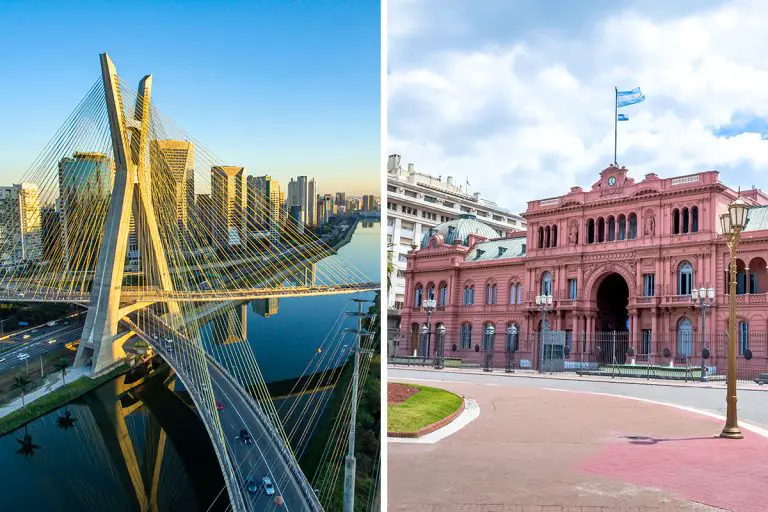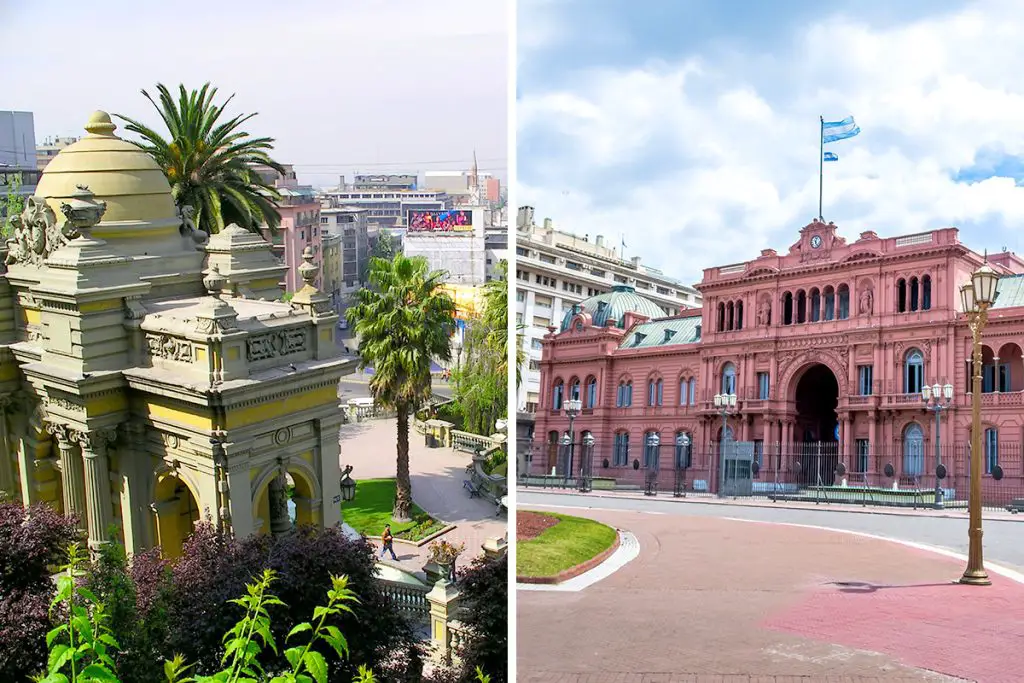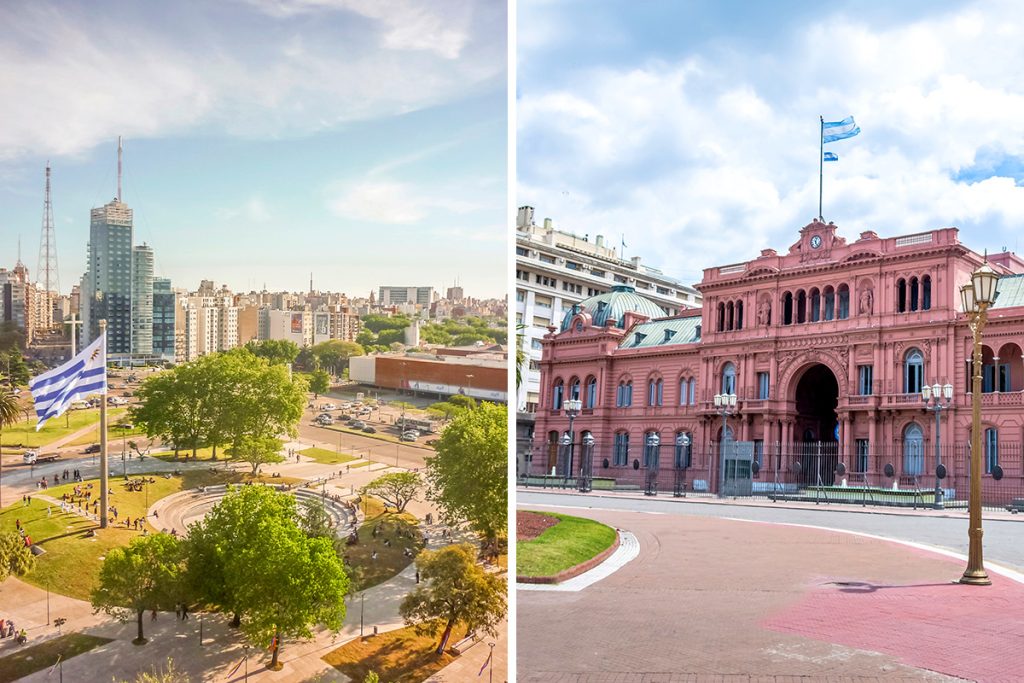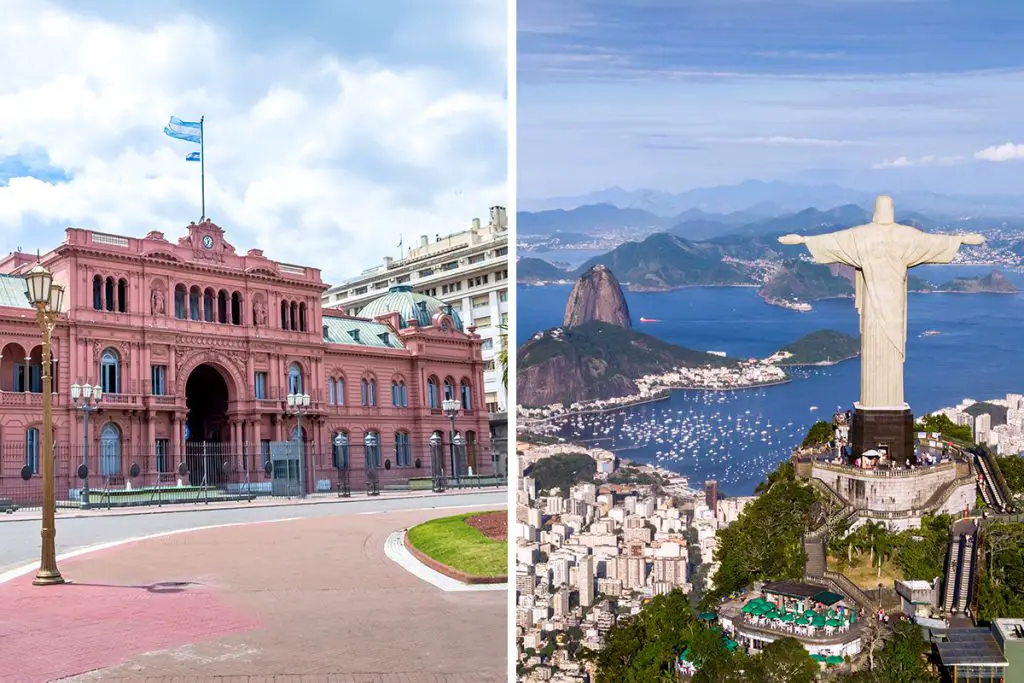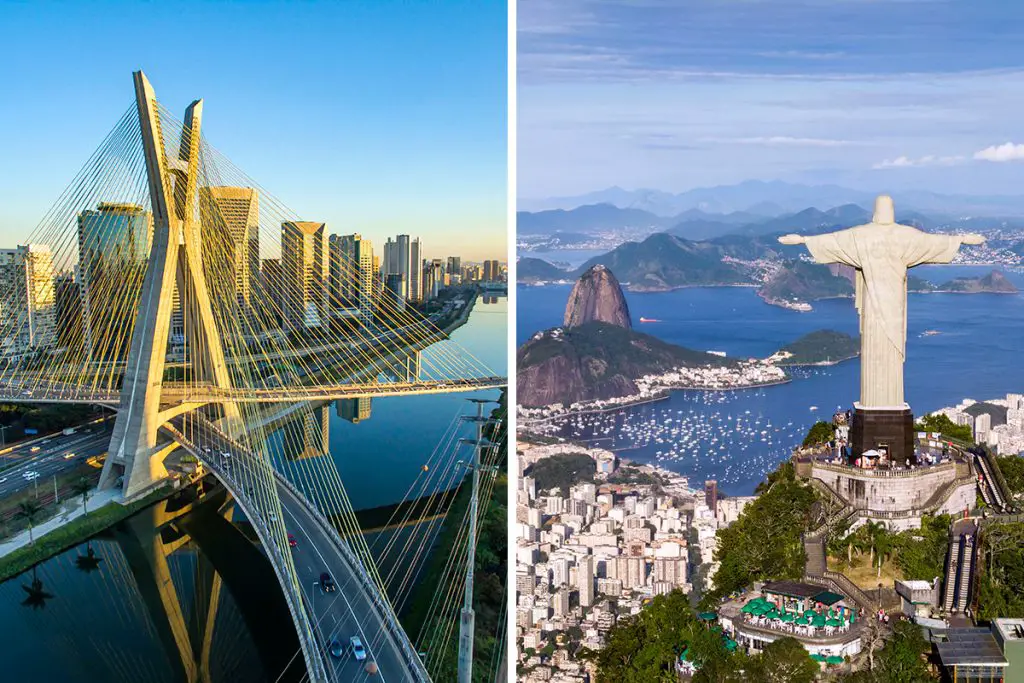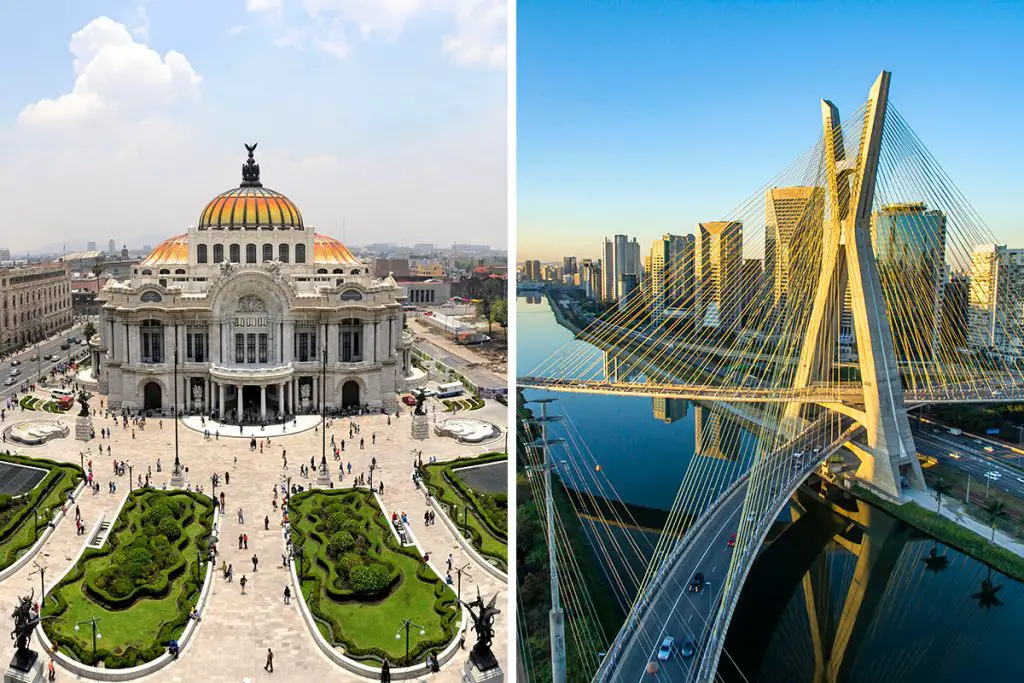The rhythm of Samba from Sao Paulo and the allure of Tango from Buenos Aires might have already tugged at your heartstrings. Each city holds a unique narrative, filled with tales of yesteryears and whispers of modernity. Your curiosity might just be the compass leading you through the rich tapestry of experiences waiting to be unraveled. So why not delve deeper into the heart of these cities?
History & Culture
Sao Paulo’s history is a vibrant tale of growth, from a small Jesuit mission village to a sprawling metropolis. Its culture is a melting pot, with influences from all over the globe shaping its identity. The city’s contemporary vibe is a testament to its ever-evolving nature, embracing change and innovation at every corner.
In contrast, Buenos Aires boasts a rich historical lineage stretching back to the colonial era. The city’s European architectural flair reflects its deep-rooted traditions, blending seamlessly with its Latin American essence. Buenos Aires’ culture is like a fine wine, it has matured over centuries, embodying a graceful blend of old-world charm and modern elegance.
As you stroll through Sao Paulo’s streets, you’ll notice a youthful spirit encapsulated in its modern art, music, and fashion. The city’s essence is always on the move, thriving on the buzz of the new and the now. The dynamism here is palpable, fueling a never-ending zest for life among its residents.
On the flip side, walking through the avenues of Buenos Aires, you’d be enveloped by a sense of nostalgia. The city holds its history close to its heart, reflected in its classical music, literature, and performing arts. The calm elegance contrasts with Sao Paulo’s bustling energy, offering a serene yet invigorating stroll down memory lane.
Summarizing, Sao Paulo offers a contemporary, dynamic culture, urging you to keep pace with its lively rhythm. Buenos Aires invites you into a rich historical narrative, enveloping you in a tapestry of classical elegance. Both cities hold unique allure, and your choice could hinge on whether you’re drawn to the pulsing beat of the new or the graceful dance of the old.
Attractions & Activities
Embarking on a journey to either Sao Paulo or Buenos Aires, you’ll find that both cities have a plethora of attractions and activities to offer. The essence of each city is captured not just in its historical landmarks but also in the daily hustle and bustle, the experiences that leave lasting imprints on your soul. Here’s a closer look at what each city holds for you.
Sao Paulo is a haven for modern art enthusiasts. The city is home to the São Paulo Museum of Art which hosts a vast collection of European art. Furthermore, the cultural scene is enriched by its array of theaters and concert halls, where the rhythm of Brazil comes to life.
Paulista Avenue, the heart of the city, is a hub for cultural activities and events that showcase the modern spirit of Sao Paulo.
On the contrary, Buenos Aires is a city that prides itself on its historical landmarks.
The iconic Obelisk stands tall as a symbol of the city’s rich past. Moreover, the Teatro Colon, known for its remarkable acoustics and architectural elegance, is a haven for those who appreciate classical performances. The city’s parks, like the Bosques de Palermo, offer a tranquil escape amidst the hustle of urban life.
The adventurous at heart will find Sao Paulo’s green spaces like the Ibirapuera Park a perfect spot for a leisurely jog or a bicycle ride. The city’s canopy tours and hiking trails in the nearby Cantareira State Park offer a closer interaction with nature, providing a different perspective of the urban jungle.
Buenos Aires, on the other hand, enchants with its tango dance experiences. The city that birthed the sensual dance invites you to learn the tango in numerous dance halls known as milongas. The rhythm of Buenos Aires is slower, yet filled with passion, allowing you to immerse in activities that resonate with the city’s soul.
In summary, Sao Paulo thrills with its modern art scene and active lifestyle while Buenos Aires charms with its historical landmarks and the timeless dance of tango. The contrast in experiences is a reflection of the cities’ diverse cultural landscapes, each offering a unique set of memories waiting to be made.
Beaches
The allure of the coastline is undeniable when considering Sao Paulo and Buenos Aires. Both cities have proximity to beautiful shores, yet the experiences they offer are quite distinct. Let’s delve into the coastal charm these cities hold.
Sao Paulo has the advantage of being closer to the coastline with beaches like Santos and Guarujá just about 70 kilometers (43.5 miles) away. The beaches here offer a perfect getaway from the city’s hustle, with wide stretches of golden sands and a backdrop of lush green mountains.
The beach towns have a laid-back vibe yet offer a variety of watersports for the more adventurous souls.
Buenos Aires, being farther from the coast, has a different beach scene. The city is about 400 kilometers (248.5 miles) away from the renowned Mar del Plata, a charming beach town known for its serene coastline and picturesque cliffs. Though a longer journey, the escape to Mar del Plata offers a tranquil respite with a touch of elegance, characteristic of Buenos Aires.
While Sao Paulo’s nearby beaches provide a quick escape with a variety of outdoor activities, the journey to Buenos Aires’ coastal retreats is a longer one, yet rewarding with serene landscapes and a calm atmosphere.
In terms of accessibility and variety, Sao Paulo takes a slight lead with its closer beaches and array of watersports. However, the tranquil and elegant beach experience near Buenos Aires offers a different kind of allure, a peaceful retreat mirroring the city’s graceful charm.
Summarizing, the beach experiences near Sao Paulo and Buenos Aires extend the essence of each city to the shores. Whether you seek a quick adventure or a serene retreat, the choice between Sao Paulo and Buenos Aires could lead you to the beach day of your dreams.
Eating, Drinking & Nightlife
Embarking on a culinary journey in Sao Paulo and Buenos Aires is like stepping into a world where every flavor tells a story. The essence of a city can often be discovered through its food, drinks, and nightlife, each element narrating a unique tale of local traditions and modern influences.
Sao Paulo’s culinary scene is as diverse as its population. The city offers a gastronomic journey around the world, with an impressive array of international cuisine. Yet, the local flavors shine through in traditional dishes like feijoada, a hearty black bean stew, and pastel, a crispy pastry filled with various fillings.
Buenos Aires offers a culinary experience deeply rooted in its cultural heritage. The city is renowned for its steakhouses, where the asado (barbecue) is more than just a meal, it’s a social event. The flavor of grilled meats, accompanied by Malbec wine, encapsulates the Argentine tradition.
When it comes to drinking, Sao Paulo is known for its vibrant cocktail scene. The city’s bartenders are adept at crafting drinks that are as visually appealing as they are flavorful. Caipirinha, a mix of cachaça, sugar, and lime, is a local favorite that you’d find rejuvenating.
On the flip side, Buenos Aires has a rich wine culture. The city offers a myriad of wine bars and old-fashioned taverns where you can savor the famous Argentine wines. The ambiance is often relaxed, allowing for leisurely sips amidst conversations.
The nightlife in Sao Paulo is energetic with a variety of clubs and bars playing a mix of contemporary tunes and Brazilian beats. In Buenos Aires, the nightlife is synonymous with tango dancing. The milongas come alive at night, offering a glimpse into the city’s soul.
In summary, whether you’re savoring a meal, enjoying a drink, or dancing the night away, both Sao Paulo and Buenos Aires offer unique experiences. The choice between a modern eclectic vibe or a traditional, soulful rhythm could define your nocturnal adventures in these cities.
Shopping
The allure of shopping, the joy of discovering unique finds, and the satisfaction of a good bargain are universal. Sao Paulo and Buenos Aires, each with their distinctive charm, provide diverse shopping experiences. Let’s delve into the retail landscapes of these cities.
Sao Paulo is a modern shopper’s paradise. The city boasts numerous contemporary shopping malls like Shopping Iguatemi and Shopping JK Iguatemi, where international and Brazilian brands vie for your attention. Additionally, the city’s street markets offer a variety of local crafts, antiques, and unique finds that reflect the eclectic nature of Sao Paulo.
Buenos Aires, with its European influence, presents a more classical shopping experience. The city is known for its leather goods, and shops like Rossi & Caruso and Prüne are popular spots to pick up high-quality leather items. Moreover, the elegant Galerías Pacífico shopping mall is a testament to Buenos Aires’ architectural charm, housing both international and Argentine brands.
In Sao Paulo, you’ll also find a thriving scene for avant-garde fashion with boutiques that showcase the creativity of local designers. The juxtaposition of modern and traditional can be seen in the variety of goods available, offering something for every taste.
In contrast, Buenos Aires offers a more curated shopping experience. The city’s boutiques often have a classic touch, with a focus on quality and tradition. The Sunday Feria de San Telmo is a notable market where you can find vintage items and antiques, offering a nostalgic shopping experience.
Summarizing, Sao Paulo provides a bustling, modern shopping environment with a wide range of goods, while Buenos Aires offers a refined, traditional shopping experience with a focus on quality and local craftsmanship. The contrasting retail landscapes of these cities cater to different tastes, ensuring a memorable shopping adventure whether you seek modern trends or classic elegance.
Accommodation
A comfortable stay forms the cornerstone of an enjoyable vacation. Both Sao Paulo and Buenos Aires offer a range of accommodation options, each reflecting the city’s character. Let’s delve into the distinctive lodging experiences these cities offer.
Sao Paulo, being a modern metropolis, hosts a variety of contemporary hotels and serviced apartments. The city’s skyline is dotted with high-rise hotels offering panoramic views of the urban expanse. Notable neighborhoods like Jardins and Vila Madalena offer boutique hotels that provide a cozy, personalized experience.
Buenos Aires, with its European charm, provides a contrasting accommodation scene. The city is known for its elegant, classical hotels and quaint bed-and-breakfast establishments. The Recoleta and Palermo neighborhoods are particularly known for their stylish lodgings that reflect the city’s historical elegance.
In Sao Paulo, the accommodation often comes with modern amenities, providing a comfortable and convenient stay for the urban traveler. The service is streamlined, aiming to cater to the needs of a busy itinerary.
In Buenos Aires, the emphasis is often on providing a charming and intimate experience. The service is warm and personalized, allowing you to soak in the city’s graceful ambiance.
Summarizing, Sao Paulo offers a modern, convenient lodging experience, catering to those on the move. Buenos Aires, on the other hand, invites you to a more nostalgic, intimate stay, allowing a deeper connection with the city’s genteel character.
Family-Friendliness & Children’s Activities
When traveling with family, the availability of child-friendly activities and a welcoming environment is paramount. Sao Paulo and Buenos Aires, each with their unique charm, provide varied experiences for families.
Sao Paulo has numerous parks and open spaces where children can frolic and play. The Ibirapuera Park, with its expansive green areas, playgrounds, and interactive museums, offers a delightful day out for families. Additionally, the Sao Paulo Zoo and the Butantan Institute provide educational yet fun experiences for kids.
Buenos Aires, often termed the Paris of South America, also boasts a range of family-friendly activities. The city’s numerous parks like the Bosques de Palermo provide ample space for outdoor fun. Furthermore, the Temaiken Biopark and the Children’s Museum are great spots for an educational and interactive day out.
In Sao Paulo, the cultural events and festivals often have a segment dedicated to children, making the city’s vibrant culture accessible to young minds. The workshops and events held at cultural centers provide a platform for kids to learn and engage with the local culture.
Similarly, Buenos Aires hosts children-centric tango shows and cultural events that allow kids to immerse in the Argentine culture in a fun and interactive way.
In summary, both Sao Paulo and Buenos Aires offer a friendly environment and a plethora of activities for families. Whether exploring the outdoors or engaging with the local culture, families will find enriching experiences in both cities, each with its unique flavor.
Getting There & Getting Around
The ease of access and navigation through a city significantly impacts the overall travel experience. Let’s compare how Sao Paulo and Buenos Aires fare in terms of reaching the city and moving around once you’re there.
Sao Paulo is served by two major airports, Guarulhos International Airport and Congonhas Airport. Guarulhos is about 25 kilometers (15.5 miles) from the city center and is the primary hub for international flights. Congonhas, closer to the city center, caters mainly to domestic flights.
Buenos Aires has two main airports as well; Ezeiza International Airport for international flights, and Aeroparque Jorge Newbery for domestic and regional flights. Ezeiza is located 32 kilometers (19.9 miles) from the city center, while Aeroparque is conveniently located near the city center.
In Sao Paulo, the public transportation system comprises buses, subways, and taxis. The metro system is efficient and covers a broad swath of the city, making it a convenient choice for getting around. Additionally, rideshare apps are prevalent, providing a comfortable alternative to public transport.
In Buenos Aires, the public transport is well-organized with buses, subways (Subte), and taxis. The Subte is the quickest way to traverse the city, with extensive coverage that allows easy access to various neighborhoods. Rideshare apps are also readily available, offering a convenient choice for transportation.
In summary, both cities are well-connected by air and have efficient public transportation systems for internal commuting. The choice between Sao Paulo and Buenos Aires may come down to personal preference, whether you prioritize closer airports or a particular mode of inner-city transportation.
Weather
The weather can significantly influence your travel experience. A comparative look at the climates of Sao Paulo and Buenos Aires will help in planning your visit better. Let’s explore the meteorological contrasts between these two vibrant cities.
Sao Paulo experiences a tropical rainforest climate, with a relatively consistent temperature year-round. The average temperature hovers around 68°F to 77°F (20°C to 25°C). The summer months from December to March can get warm, with temperatures occasionally reaching 86°F (30°C). The winters, from June to August, are mild and the temperature rarely dips below 55°F (12.7°C).
On the other hand, Buenos Aires has a humid subtropical climate, with more distinct seasonal variations. The summers (December to February) are warm with temperatures ranging from 77°F to 90°F (25°C to 32.2°C). Winters (June to August) are milder with temperatures averaging between 46°F to 59°F (7.7°C to 15°C).
Rainfall in Sao Paulo is quite distributed throughout the year, though it peaks in the summer months. The city can experience sudden showers, keeping the city lush and green.
Buenos Aires experiences its highest rainfall during the summer months, similar to Sao Paulo. However, the rain is usually less intense, and the city has many clear days throughout the year.
In summary, Sao Paulo offers a more consistent, tropical climate, while Buenos Aires experiences a wider range of temperatures with distinct seasons. Your choice might depend on your preference for tropical warmth or a temperate climate with varied seasons.
Safety
Safety is a prime consideration for travelers. Understanding the safety dynamics of Sao Paulo and Buenos Aires can provide a clearer picture for planning your trip.
Generally, both cities have neighborhoods with varying levels of safety, and being vigilant, especially after dark, is advisable. Petty thefts like pickpocketing and bag snatching can occur in crowded areas and public transport.
In terms of non-crime-related safety, Sao Paulo has a well-structured healthcare system with numerous hospitals and clinics. Similarly, Buenos Aires has a robust healthcare infrastructure, ensuring that medical help is accessible in case of emergencies.
Traffic can be quite dense in both cities, and adhering to road safety guidelines is crucial. It’s advisable to be cautious while crossing streets and be aware of the local driving habits.
Both cities have made efforts to improve safety and security for residents and visitors alike. There are designated tourist police in Buenos Aires, and Sao Paulo has also taken measures to enhance safety in key tourist areas.
Summarizing, while both cities have their own set of challenges, being cautious and adhering to safety guidelines can contribute to a secure and enjoyable experience in either Sao Paulo or Buenos Aires.
Cost
The cost of a vacation can influence your choice of destination. Comparing the costs between Sao Paulo and Buenos Aires can provide insight into how your budget would fare in either city.
In Sao Paulo, a three-course meal at a mid-range restaurant can cost around R$ 100 (USD 19.50) per person, while in Buenos Aires, a similar meal may cost around ARS 4,600 (USD 13.10).
Lodging in Sao Paulo, being a business hub, might be on the higher side compared to Buenos Aires. A standard double room in a mid-range hotel in Sao Paulo might cost around USD 170 per night, while in Buenos Aires, it could be around USD 215 per night.
Transportation costs are relatively lower in Buenos Aires with a one-way ticket on public transport costing around ARS 25 (USD 0.07), whereas in Sao Paulo, it costs around R$ 4.40 (USD 0.85).
Both cities offer a range of prices depending on the area and the type of service, but overall, Buenos Aires may be a more budget-friendly option compared to Sao Paulo.
In summary, your money might stretch a bit further in Buenos Aires with lower costs for food, lodging, and transportation. However, both cities offer a range of options catering to different budget levels, ensuring a memorable experience regardless of your financial plan.
Which Is Better – Sao Paulo or Buenos Aires?
The quest to choose between Sao Paulo and Buenos Aires for your next excursion could hinge on various factors reflecting your personal preferences and the kind of experiences you yearn for. Let’s recapitulate the distinguishing elements of these South American metropolises.
In the realm of History & Culture, Sao Paulo emerges as a modern, dynamic city with a melting pot of global influences, offering a contemporary cultural vibe. Buenos Aires, on the other hand, holds a rich historical narrative with a profound European architectural influence, providing a serene yet invigorating stroll down memory lane.
When it comes to Attractions & Activities, Sao Paulo’s modern art scene, green spaces, and adventurous outdoor activities contrast with Buenos Aires’ historical landmarks and the timeless, sensual dance of tango.
The Beaches near Sao Paulo provide a quicker escape with a variety of outdoor activities while Buenos Aires’ tranquil and elegant beach experience offers a peaceful retreat.
Diving into the Eating, Drinking & Nightlife, Sao Paulo presents a modern, vibrant scene compared to Buenos Aires’ traditional, soulful rhythm encapsulated in its culinary and nocturnal adventures. Shopping in Sao Paulo offers a bustling, modern environment, whereas Buenos Aires provides a refined, traditional shopping experience focusing on quality and local craftsmanship.
Accommodation in Sao Paulo leans towards modern, convenient lodging experiences while Buenos Aires invites you to a nostalgic, intimate stay. In the sphere of Family-Friendliness & Children’s Activities, both cities present enriching experiences for families, each with its unique flavor, encompassing outdoor fun and cultural engagement.
The ease of Getting There & Getting Around in both cities is facilitated by well-connected airports and efficient public transportation systems, though personal preferences might lean towards one over the other.
Weather in Sao Paulo is tropical and consistent, contrasting with Buenos Aires’ subtropical climate with distinct seasons. Safety considerations are paramount in both cities with various measures in place to ensure a secure experience.
Cost-wise, Buenos Aires may edge out with lower costs for food, lodging, and transportation, potentially offering a more budget-friendly experience compared to Sao Paulo.
Your choice between Sao Paulo and Buenos Aires might boil down to whether you seek the energetic pulse of a modern metropolis or the graceful elegance of a historical city. Each city holds its unique charm and a plethora of experiences awaiting to be discovered, ensuring an unforgettable adventure regardless of your choice.

